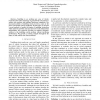Free Online Productivity Tools
i2Speak
i2Symbol
i2OCR
iTex2Img
iWeb2Print
iWeb2Shot
i2Type
iPdf2Split
iPdf2Merge
i2Bopomofo
i2Arabic
i2Style
i2Image
i2PDF
iLatex2Rtf
Sci2ools
IROS
2009
IEEE
2009
IEEE
A new modular schema for the control of tumbling robots
— Tumbling is an exciting new area of robotic locomotion that takes advantage of ground-body interactions to achieve rich motions with minimal hardware complexity. The increased mobility of tumbling robots, however, comes at the price of increased control complexity. In this paper, we propose a novel method to handle the issues of tumbling locomotion which takes the problem and separates into locally independent subproblems. Our approach provides an intuitive geometric solution to the tumbling control problem without sacrificing performance. We provide a running example throughout the paper to help solidify the ideas presented.
Related Content
| Added | 24 May 2010 |
| Updated | 24 May 2010 |
| Type | Conference |
| Year | 2009 |
| Where | IROS |
| Authors | Brett Hemes, Nikolaos Papanikolopoulos |
Comments (0)

